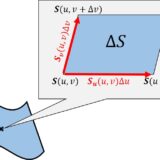Previous posts:
Integrals and Miscellaneous 17
Integrals and Miscellaneous 16
Integrals and Miscellaneous 15
Integrals and Miscellaneous 14
Integrals and Miscellaneous 13
Integrals and Miscellaneous 12
Integrals and Miscellaneous 11
Integrals and Miscellaneous 10
From @SrinivasR1729:
If we have integrals:\begin{eqnarray*}\int_0^\infty\left(e^{\frac{2}{3}x}-\frac{2}{3}\right)^2\frac{\tanh\frac{x}{2}+\tanh2x}{x}e^{-4x}dx&=&\frac{2}{9}\ln P\\\int_0^\infty\left(e^{\frac{2}{3}x}+\frac{2}{3}\right)^2\frac{\tanh\frac{x}{2}+\tanh2x}{x}e^{-4x}dx&=&\frac{2}{9}\ln Q\end{eqnarray*}then show that $$\sqrt[12]{PQ}=\frac{\sqrt[3]{2}\G(\frac{1}{3})^9}{5^\frac{3}{2} 3^\frac{2}{3}\pi^\frac{9}{2}}$$PROOF.$$K(a,b):=\int_0^\infty e^{-ax}\tanh bx\frac{dx}{x}\quad(a,b>0)$$\begin{eqnarray*}\dd{K}{a} &=& -\int_0^\infty e^{-ax}(1-e^{-2bx})\sum_{n=0}^\infty(-1)^ne^{-2bnx}dx \\&=&-\sum_{n=0}^\infty(-1)^n\left(\frac{1}{a+2bn}-\frac{1}{a+2b+2bn}\right) \\&=& -\sum_{n=0}^\infty(-1)^n\left(\frac{1}{a+4bn}-\frac{2}{a+2b+4bn}+\frac{1}{a+4b+4bn}\right) \\&=&\frac{1}{4b}\left[\psi\left(\frac{a}{4b}\right)-2\psi\left(\frac{a+2b}{4b}\right)+\psi\left(\frac{a+4b}{4b}\right)\right]\end{eqnarray*}Therefore,$$K(a,b)=\ln\frac{\G(\frac{a}{4b})\G(\frac{a+4b}{4b})}{\G(\frac{a+2b}{4b})^2}+C(b)$$We find $K\to 0$ as $a\to \infty$ then$$K(a,b)=\ln\frac{\G(\frac{a}{4b})\G(\frac{a+4b}{4b})}{\G(\frac{a+2b}{4b})^2}$$Now we see that \begin{eqnarray*}&&\int_0^\infty\left(e^{\frac{2}{3}x}\mp\frac{2}{3}\right)^2\frac{\tanh\frac{x}{2}+\tanh2x}{x}e^{-4x}dx\\&=& K(8/3,1/2)+K(8/3,2)\mp\frac{4}{3}(K(10/3,1/2)+K(10/3,2))+\frac{4}{9}(K(4,1/2)+K(4,2))\end{eqnarray*}then we can find the closed forms of the integrals after boring calculation.
Adding the two integrals yields\begin{eqnarray*}\frac{2}{9}\ln PQ &=&2K(8/3,1/2)+2K(8/3,2)+\frac{8}{9}(K(4,1/2)+K(4,2)) \\ &=&\frac{2}{9}\ln\frac{2^4\G(\frac{1}{3})^{72}}{5^{18}3^8\pi^{54}}\end{eqnarray*}Hence,$$\sqrt[12]{PQ}=\frac{\sqrt[3]{2}\G(\frac{1}{3})^9}{5^\frac{3}{2} 3^\frac{2}{3}\pi^\frac{9}{2}}$$
$$\int_0^1\left(\frac{x^{p-1}}{1-x}-\frac{rx^{q-1}}{1-x^r}\right)dx=\psi\left(\frac{q}{r}\right)-\psi(p)+\ln r\;\quad(p,q,r>0)$$PROOF.\begin{eqnarray*}LHS &=& \lim_{\epsilon,\delta\to +0}\int_\epsilon^{1-\delta}\sum_{n=0}^\infty\left(x^{n+p-1}-rx^{rn+q-1}\right)dx \\&=& \lim_{\epsilon,\delta\to +0}\sum_{n=0}^\infty\left[\frac{(1-\delta)^{n+p}-\epsilon^{n+p}}{n+p}-\frac{(1-\delta)^{rn+q}-\epsilon^{rn+q}}{n+\frac{q}{r}}\right]\end{eqnarray*}By ratio test we find the $\epsilon$ terms converge and tend to zero. Hence,\begin{eqnarray*} &=& \lim_{\delta\to +0}\left[\frac{(1-\delta)^p}{p} F\left[\begin{matrix}1,p\\p+1\end{matrix};1-\delta\right]-\frac{r(1-\delta)^q}{q} F\left[\begin{matrix}1,\frac{q}{r}\\\frac{q}{r}+1\end{matrix};(1-\delta)^r\right]\right]\end{eqnarray*}Recall the formula proven here :$$F\left[\begin{matrix}a,b\\a+b\end{matrix};z\right]=\frac{1}{B(a,b)}\sum_{n=0}^\infty\frac{(a)_n(b)_n}{n!^2}(1-z)^n\left[2\psi(n+1)-\psi(a+n)-\psi(b+n)-\ln(1-z)\right]$$, which gives\begin{eqnarray*}&&\int_0^1\left(\frac{x^{p-1}}{1-x}-\frac{rx^{q-1}}{1-x^r}\right)dx \\&=& \lim_{\delta\to +0}\left[(1-\delta)^p\bigl(\psi(1)-\psi(p)-\ln\delta\bigr)-(1-\delta)^q\left\{\psi(1)-\psi\left(\frac{q}{r}\right)-\ln\bigl(1-(1-\delta)^r\bigr)\right\}\right] \\&=& \lim_{\delta\to +0}\left[\left\{\psi(1)-\psi(p)-\ln\delta+O(\delta)\right\}-\left\{\psi(1)-\psi\left(\frac{q}{r}\right)+O(\delta)\right\}+(1-\delta)^q\ln\bigl(1-(1-\delta)^r\bigr)\right]\\&=&\lim_{\delta\to +0}\left[-\psi(p)-\ln\delta+\psi\left(\frac{q}{r}\right)+O(\delta)+(1-\delta)^q\ln r\delta(1+O(\delta))\right]\\&=&\lim_{\delta\to +0}\left[-\psi(p)-\ln\delta+\psi\left(\frac{q}{r}\right)+(1-\delta)^q\ln r\delta +O(\delta)\right]\\&=&\psi\left(\frac{q}{r}\right)-\psi(p)+\ln r\end{eqnarray*}
REFERENCE:
G.E.Andrews, G.C.Berndt, "Ramanujan's Lost Notebook IV" (2013), §6.2

Ramanujan's Lost Notebook Part IV(rakuten,ebook)
Suppose $a,c>0$ , $b>1$ then$$I(a,b,c):=\int_0^1\left(\frac{x^{c-1}}{1-x}-\frac{bx^{bc-1}}{1-x^b}\right)\sum_{k=0}^\infty x^{ab^k}dx=\psi\left(\frac{a}{b}+c\right)+\ln\frac{b}{a}$$PROOF. We consider the partial sum, namely\begin{eqnarray*}I_n(a,b,c) &=& \int_0^1\left(\frac{x^{c-1}}{1-x}-\frac{bx^{bc-1}}{1-x^b}\right)\sum_{k=0}^n x^{ab^k}dx \\&=& \sum_{k=0}^n\int_0^1\left(\frac{x^{ab^k+c-1}}{1-x}-\frac{bx^{ab^k+bc-1}}{1-x^b}\right)dx\end{eqnarray*}Recall the formula$$\int_0^1\left(\frac{x^{p-1}}{1-x}-\frac{rx^{q-1}}{1-x^r}\right)dx=\psi\left(\frac{q}{r}\right)-\psi(p)+\ln r\;\quad(p,q,r>0)$$which we obtained "2023/5/10" above. Hence,\begin{eqnarray*}I_n(a,b,c)&=&\sum_{k=0}^n\left[\psi(ab^{k-1}+c)-\psi(ab^k+c)+\ln b\right] \\&=& \psi\left(\frac{a}{b}+c\right)-\psi(ab^n+c)+(n+1)\ln b\end{eqnarray*}We deduced here that$$\psi(x+1)=\frac{1}{2x}+\log x-\int_0^\infty\left(\frac{1}{2}-\frac{1}{t}+\frac{1}{e^t-1}\right)e^{-xt}dt$$From $|\frac{1}{2}-\frac{1}{t}+\frac{1}{e^t-1}|\le \frac{1}{2}$ it follows that $$\psi(x)\approx \ln x \quad\mathrm{as} \;x\to\infty$$So taking the limit of $n\to \infty$ yields\begin{eqnarray*}I(a,b,c)&=&\lim_{n\to\infty}\left[\psi\left(\frac{a}{b}+c\right)-\ln(ab^n+c)+(n+1)\ln b\right]\\&=&\psi\left(\frac{a}{b}+c\right)+\ln\frac{b}{a}\end{eqnarray*}
Especially when $a=b$ , $c=1$ , the result is$$I(a,a,1)=\int_0^1\frac{1-ax^{a-1}+(a-1)x^a}{(1-x)(1-x^a)}\sum_{k=1}^\infty x^{a^k}dx=1-\g\quad(a>1)$$Besides, setting $a=2,3$ the special values are\begin{eqnarray*}&&\int_0^1\frac{1}{1+x}\sum_{k=1}^\infty x^{2^k}dx=1-\g \\ &&\int_0^1\frac{1+2x}{1+x+x^2}\sum_{k=1}^\infty x^{3^k}dx=1-\g\end{eqnarray*}
REFERENCE:
【γ16】ビネの第1公式(導出が技巧的!)
G.E.Andrews, G.C.Berndt, "Ramanujan's Lost Notebook IV" (2013), §6.2

Ramanujan's Lost Notebook Part IV(rakuten,ebook)
From @SeriesIntegral $$I:=\int_0^\pi\ln\left(\frac{5}{4}+\cos x\right)dx=0$$PROOF.$$f(z):=\frac{\ln(z+\frac{1}{2})}{z}dz$$We define the contour $C$ as below.
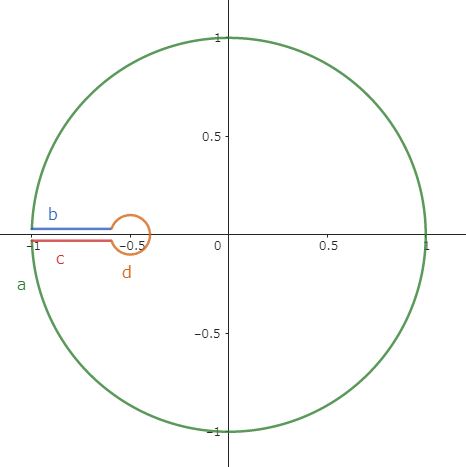
The residue theorem gives $$\oint_C f(z)dz=-2\pi i\ln 2$$and we calculate the four paths as:\begin{eqnarray*}\oint_C f(z)dz&=&i\int_0^\pi\ln\left(e^{i\t}+\frac{1}{2}\right)d\t +i\int_{-\pi}^0\ln\left(e^{i\t}+\frac{1}{2}\right)d\t\\&&+i\int_\pi^{-\pi}\frac{\epsilon e^{i\t}\ln(\epsilon e^{i\t})}{\epsilon e^{i\t}-\frac{1}{2}}d\t+\int_0^\frac{1}{2}\frac{\ln x-i\pi}{-x-\frac{1}{2}}(-dx)+\int^0_\frac{1}{2}\frac{\ln x+i\pi}{-x-\frac{1}{2}}(-dx)\\&=& i\int_0^\pi\ln\left(\frac{5}{4}+\cos \t\right)d\t-2\pi i\int_0^\frac{1}{2}\frac{dx}{x+1/2} \\&=& iI-2\pi i\ln2\end{eqnarray*}$$\therefore\quad I=0$$
From @SeriesIntegral $$\sum_{n=1}^\infty (-1)^n\ln\left(1+\frac{1}{n}\right)=\ln\frac{2}{\pi}$$PROOF.$$S_N:=\sum_{n=1}^N (-1)^n\ln\left(1+\frac{1}{n}\right)$$\begin{eqnarray*}S_{2N} &=& \sum_{n=1}^N\ln\frac{(2n+1)(2n-1)}{(2n)^2} \\&=& \ln\frac{\G(N+\frac{3}{2})\G(N+\frac{1}{2})}{\G(N+1)\G(N+1)}+\ln\frac{2}{\pi}\end{eqnarray*}Recall the formula$$\lim_{z\to\infty}\frac{\G(z+a_1)\G(z+a_2)\cdots\G(z+a_k)}{\G(z+b_1)\G(z+b_2)\cdots\G(z+b_k)}=1$$where $\sum_{i=0}^k a_i=\sum_{i=0}^k b_i$, proven here. Hence,$$\lim_{N\to\infty}S_{2N}=\ln\frac{2}{\pi}$$$$S_{2N+1}=S_{2N}-\ln\left(1+\frac{1}{2N+1}\right)\xrightarrow[]{N\to\infty} \ln\frac{2}{\pi}$$Therefore,$$\sum_{n=1}^\infty (-1)^n\ln\left(1+\frac{1}{n}\right)=\ln\frac{2}{\pi}$$
Find the image of the following line under the transformation $w=z^2$.
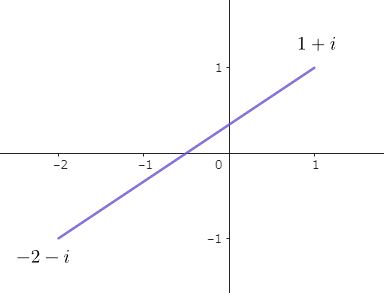
SOLUTION.
The line can be written as $z=(1-3t)+i(1-2t)$ where $0\le t\le 1$. We find$$w=u+iv=(5t^2-2t)+i\cdot(2t-1)(3t-1)$$Eliminating $t$ gives$$144u^2-120uv+25v^2-20u-48v-4=0$$which expresses a quadratic curve.
Now we consider the rotation $u+iv=(U+iV)e^{i\t}$ , $\tan\t=-\frac{5}{12}$. It follows that $$V=\frac{13}{4}U^2-\frac{1}{13}$$Hence, we conclude that the image of $w=z^2$ is the parabola created by rotating $v=\frac{13}{4}u^2-\frac{1}{13}$ by $\arctan(-\frac{5}{12})$ around the origin.
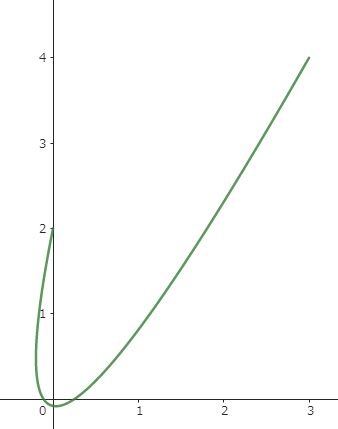
$$I(s):=\int_0^1\frac{\mathrm{artanh}sx}{x}dx=\frac{\Li_2(s)-\Li_2(-s)}{2}$$PROOF.\begin{eqnarray}I(s) &=& \sum_{n=0}^\infty\frac{s^{2n+1}}{2n+1}\int_0^1 x^{2n}dx \\&=& \sum_{n=0}^\infty\frac{s^{2n+1}}{(2n+1)^2} \\&=& \Li_2(s)-\frac{1}{4}\Li_2(s^2)\tag{1} \\ &=& \frac{\Li_2(s)-\Li_2(-s)}{2}\tag{2}\end{eqnarray}Especially,\begin{eqnarray}I(1)&=&\frac{\pi^2}{8} \\I(\phi^{-1}) &=& \frac{\pi^2}{12}-\frac{3}{4}\ln^2\phi \\ I(\phi^{-3}) &=& \frac{\pi^2}{24}-\frac{3}{4}\ln^2\phi\end{eqnarray}
REFERENCE:
John M. Campbell, Some nontrivial two-term dilogarithm identities, Irish Math. Soc. Bulletin Number 88 (2021)
From @AlnDkra $$I:=\int_0^1 x^x (1-x)^{1-x}\sin(\pi x)dx=\frac{\pi e}{24}$$PROOF.$$f(z):=z^z(1-z)^{1-z}e^{i\pi z}=e^{z\ln z+(1-z)\ln(1-z)+i\pi z}$$We also define the contour $C$ encircling the two branch points $0,1$ counter-clockwise, composed of two small arcs and two lines along the real axis. And we suppose$$-\pi\le\arg z<\pi\;,\; 0\le \arg(1-z)<2\pi$$ The branch cut exists just between $0$ and $1$, for we find f(z) is continuous when crossing the real axis at $-\epsilon$ and $1+\epsilon$.
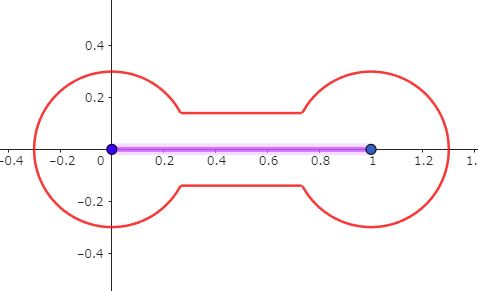
\begin{eqnarray*}\oint_Cf(z)dz &=& \int_1^0 e^{x\ln x+(1-x)(\ln(1-x)+2\pi i)+i\pi x}dx+\int_0^1 e^{x\ln x+(1-x)\ln(1-x)+i\pi x}dx\\&=& 2i\int_0^1 x^x (1-x)^{1-x}\sin(\pi x)dx \\&=& 2iI\end{eqnarray*}Then we calculate the residue:\begin{eqnarray*}\oint_Cf(z)dz &=& -2\pi i\mathrm{Res}_{z=\infty}f(z) \\&=& 2\pi i\mathrm{Res}_{z=0}\frac{1}{z^2}f\left(\frac{1}{z}\right)\\&=& 2\pi i\mathrm{Res}_{z=0}\left[\frac{1}{z^2}e^{-\frac{1}{z}\ln(1-z)}-\frac{1}{z^3}e^{-\frac{1}{z}\ln(1-z)}\right]\end{eqnarray*}We obtained here that$$\mathrm{Res}_{z=0}\left[\frac{1}{z^2}e^{-\frac{1}{z}\ln(1-z)}\right]=\frac{e}{2}$$Expanding the remaining term:\begin{eqnarray*}\frac{1}{z^3}e^{-\frac{1}{z}\ln(1-z)} &=& \frac{1}{z^3}\sum_{n=0}^\infty\frac{(-1)^n\ln^n(1-z)}{n!z^n}\\&=&\frac{1}{z^3}\left[1-\frac{1}{z}\ln(1-z)+\frac{1}{2!z^2}\ln^2(1-z)-\frac{1}{3!z^3}\ln^3(1-z)+\cdots\right]\\&=& \frac{1}{z^3}\Biggl[1+\frac{1}{z}\left(z+\frac{z^2}{2}+\frac{z^3}{3}\cdots\right)\\&&+\frac{1}{2!z^2}\left(z+\frac{z^2}{2}+\frac{z^3}{3}\cdots\right)^2\\&&+\frac{1}{3!z^3}\left(z+\frac{z^2}{2}+\frac{z^3}{3}\cdots\right)^3+\cdots\Biggr]\end{eqnarray*}Focusing on $z^{-1}$ terms to get\begin{eqnarray*}\mathrm{Res}_{z=0}\left[\frac{1}{z^3}e^{-\frac{1}{z}\ln(1-z)}\right]&=&\frac{1}{3}+\frac{1}{2}\left(\frac{1}{4}+\frac{2}{3}\right)+\frac{1}{3!}\left(\frac{3}{4}+\frac{3}{3}\right)+\frac{1}{4!}\left(\frac{6}{4}+\frac{4}{3}\right)+\cdots \\&=& \frac{1}{3}\left(1+1+\frac{1}{2!}+\frac{1}{3!}+\cdots\right)+\frac{1}{4}\left(\frac{1}{2}+\frac{3}{3!}+\frac{6}{4!}+\cdots\right)\\&=&\frac{e}{3}+\frac{1}{4}\cdot\frac{1}{2}\left(1+\frac{1}{1!}+\frac{1}{2!}+\cdots\right)\\&=&\frac{e}{3}+\frac{e}{8}=\frac{11}{24}e\end{eqnarray*}$$\therefore\quad \oint_Cf(z)dz=2\pi i\left(\frac{e}{2}-\frac{11}{24}e\right)=2\pi i\frac{e}{24}$$Hence,$$I=\frac{\pi e}{24}$$
From @SeriesIntegral $$I:=\int_0^\infty\ln\frac{1+x^2+x^4+x^6}{1+x^6}dx=\pi(\sqrt{2}-1)$$PROOF.\begin{eqnarray*}I &=& \int_0^1\left(1+\frac{1}{x^2}\right)\ln\frac{1+x^2+x^4+x^6}{1+x^6}dx \\&=& \int_0^1\left(1+\frac{1}{x^2}\right)\ln\frac{1+x^4}{1-x^2+x^4}dx\\&=&\left[\left(x-\frac{1}{x}\right)\ln\frac{1+x^4}{1-x^2+x^4}\right]_0^1- \int_0^1\left(x-\frac{1}{x}\right)\left(\frac{4x^3}{1+x^4}-\frac{4x^3-2x}{1-x^2+x^4}\right)dx\\&=&4\int_0^1\frac{x^2-x^4}{1+x^4}dx+2\int_0^1\frac{2x^4-3x^2+1}{1-x^2+x^4}dx\\&=& 4\int_0^1\frac{1+x^2}{1+x^4}dx-2\int_0^1\frac{1+x^2}{1-x^2+x^4}dx \\&=& 2\sqrt{2}\Bigl[\arctan(\sqrt{2}x+1)+\arctan(\sqrt{2}x-1)\Bigr]_0^1-2\left[\arctan\frac{x}{x^2-1}\right]_0^1 \\&=& \pi(\sqrt{2}-1)\end{eqnarray*}
$$I:=\int_0^\infty x^{p-1}\left(\frac{2}{1+\sqrt{1+4x}}\right)^q dx\quad ,\;q>0\;,\;0<p<\frac{q}{2}$$SOLUTION.\begin{eqnarray*} I&=& \int_0^\infty y^{p-1}(1+y)^{p-q-1}(1+2y)dy\quad(x=y+y^2) \\&=& \int_0^1 z^{p-1}(1-z)^{q-2p-1}(1+z)dz\quad(y=\frac{z}{1-z}) \\&=& B(p,q-2p)+B(p+1,q-2p) \\&=& \frac{\G(p)\G(q-2p)}{\G(q-p)}+\frac{\G(p+1)\G(q-2p)}{\G(q-p+1)} \\&=&\frac{q\G(p)\G(q-2p)}{\G(q-p+1)}\end{eqnarray*}Hence,$$\int_0^\infty x^{p-1}\left(\frac{2}{1+\sqrt{1+4x}}\right)^q dx=\frac{q\G(p)\G(q-2p)}{\G(q-p+1)}$$
$$I:=\int_0^\infty \frac{x^{p-1}dx}{(x+\sqrt{1+x^2})^q}\quad ,\;q>0\;,\;0<p<q$$SOLUTION.\begin{eqnarray*}I &=&\frac{1}{2^{p+1}}\int_0^1y^{\frac{q-p}{2}-1}(1-y)^{p-1}(1+y)dy\quad(x+\sqrt{1+x^2}=1/\sqrt{y})\\&=&\frac{1}{2^{p+1}}\left[B\left(\frac{q-p}{2},p\right)+B\left(\frac{q-p}{2}+1,p\right)\right] \\&=&\frac{q\G(\frac{q-p}{2})\G(p)}{2^{p+1}\G(\frac{q+p}{2}+1)}\end{eqnarray*}Hence,$$\int_0^\infty \frac{x^{p-1}dx}{(x+\sqrt{1+x^2})^q}=\frac{q\G(\frac{q-p}{2})\G(p)}{2^{p+1}\G(\frac{q+p}{2}+1)}$$
From @SrinivasR1729:
$$I:=\int_V\frac{1+x^2+y^2+z^2+w^2}{\sqrt[3]{1-x^2-y^2-z^2-w^2}}dxdydzdw\;,\quad V=\left\{(x,y,z,w)|x^2+y^2+z^2+w^2\le 1\right\}$$SOLUTION.
Substituting$$\begin{cases}x&=&r\cos\t_3\\y&=&r\sin\t_3\cos\t_2\\ z&=& r\sin\t_3\sin\t_2\cos\t_1\\w&=& r\sin\t_3\sin\t_2\sin\t_1\end{cases}$$and we then find $$dxdydzdw=r^3\sin^2\t_3\sin\t_2\:drd\t_1d\t_2d\t_3$$\begin{eqnarray*}I &=& \int_0^1dr\int_0^{2\pi}d\t_1\int_0^\pi d\t_2\int_0^\pi d\t_3\frac{1+r^2}{\sqrt[3]{1-r^2}}r^3\sin^2\t_3\sin\t_2\\&=&2\pi^2\int_0^1\frac{1+r^2}{\sqrt[3]{1-r^2}}r^3dr\\&=&\pi^2\int_0^1\frac{u+u^2}{\sqrt[3]{1-u}}du\\&=& \pi^2\left[B\left(2,\frac{2}{3}\right)+B\left(3,\frac{2}{3}\right)\right]\\&=&\frac{63}{40}\pi^2\end{eqnarray*}
Next:
Integrals and Miscellaneous 19
Please support me!

記事を気に入って下さった方、「応援してあげてもいいよ」という方がいらっしゃったら15円から可能なので支援していただければ幸いです。情報発信を継続していくため、サーバー維持費などに充てさせていただきます。
ご支援いただいた方は、こちらで確認できます。
◎ Amazonギフトの場合、
Amazonギフト券- Eメールタイプ – Amazonベーシック
より、金額は空白欄に適当に(15円から)書きこんで下さい。受取人は「mamekebiamazonあっとgmail.com」です(あっとは@に置き換えてください)。贈り主は「匿名」等でOKです。全額がクリエイターに届きます。
◎ OFUSEは登録不要で、100円から寄付できます。金額の90%がクリエイターに届きます。
OFUSEで応援を送る◎ codocは登録不要で、100円から寄付できます。金額の85%がクリエイターに届きます。

